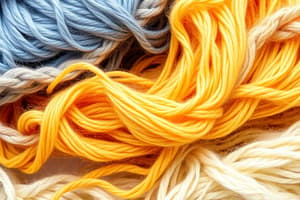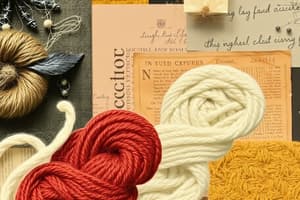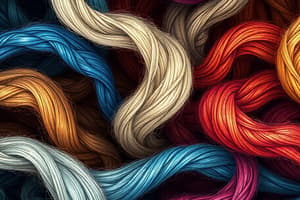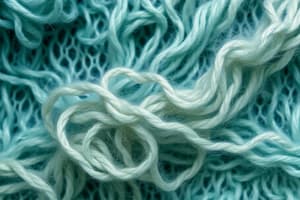Podcast
Questions and Answers
What type of fibers are obtained from the stem of flax?
What type of fibers are obtained from the stem of flax?
- Fruit fibers
- Seed fibers
- Bast fibers (correct)
- Leaf fibers
Which of these is NOT an example of an animal fiber?
Which of these is NOT an example of an animal fiber?
- Cotton (correct)
- Alpaca
- Wool
- Silk
What is the process of producing fabric by interlacing warp and weft yarns at right angles to each other called?
What is the process of producing fabric by interlacing warp and weft yarns at right angles to each other called?
- Weaving (correct)
- Dyeing
- Knitting
- Spinning
What is the main difference between satin and sateen fabric?
What is the main difference between satin and sateen fabric?
Twill weave is characterized by a diagonal pattern.
Twill weave is characterized by a diagonal pattern.
What is the process of making fabrics by interlocking yarn loops called?
What is the process of making fabrics by interlocking yarn loops called?
What type of knitting creates wales that are vertical to the course of the yarn?
What type of knitting creates wales that are vertical to the course of the yarn?
What is the most important element of color?
What is the most important element of color?
Which of these is NOT a primary color?
Which of these is NOT a primary color?
Analogous colors are directly opposite each other on the color wheel.
Analogous colors are directly opposite each other on the color wheel.
What type of clothing is designed to be worn for sports or other physical activities?
What type of clothing is designed to be worn for sports or other physical activities?
What type of clothing is worn next to the skin?
What type of clothing is worn next to the skin?
What type of clothing is considered informal and comfortable for relaxing at home?
What type of clothing is considered informal and comfortable for relaxing at home?
What type of accessories is worn around the neck?
What type of accessories is worn around the neck?
Flashcards
What are textile fibres?
What are textile fibres?
Textile fibres are materials, either natural or synthetic, with a length significantly greater than their width. They are used to create yarn, which in turn is used to make fabrics.
What are staple fibres?
What are staple fibres?
Staple fibres are short fibres, typically found in natural fibres like cotton and wool.
What are filament fibres?
What are filament fibres?
Filament fibres are continuous or near-continuous long fibres. They're typically found in man-made fibres like rayon and silk.
What are plant fibres?
What are plant fibres?
Signup and view all the flashcards
What are animal fibres?
What are animal fibres?
Signup and view all the flashcards
What are bast fibres?
What are bast fibres?
Signup and view all the flashcards
What are leaf fibres?
What are leaf fibres?
Signup and view all the flashcards
What are seed fibres?
What are seed fibres?
Signup and view all the flashcards
What are fruit fibres?
What are fruit fibres?
Signup and view all the flashcards
What are grass fibres?
What are grass fibres?
Signup and view all the flashcards
What are hair fibres?
What are hair fibres?
Signup and view all the flashcards
What are secretion fibres?
What are secretion fibres?
Signup and view all the flashcards
What are synthetic fibres?
What are synthetic fibres?
Signup and view all the flashcards
What are regenerated fibres?
What are regenerated fibres?
Signup and view all the flashcards
What are inorganic fibres?
What are inorganic fibres?
Signup and view all the flashcards
What is yarn?
What is yarn?
Signup and view all the flashcards
What is weaving?
What is weaving?
Signup and view all the flashcards
What is knitting?
What is knitting?
Signup and view all the flashcards
What are warp yarns?
What are warp yarns?
Signup and view all the flashcards
What are weft yarns?
What are weft yarns?
Signup and view all the flashcards
What is plain weave?
What is plain weave?
Signup and view all the flashcards
What is satin weave?
What is satin weave?
Signup and view all the flashcards
What is twill weave?
What is twill weave?
Signup and view all the flashcards
What is weft knitting?
What is weft knitting?
Signup and view all the flashcards
What is warp knitting?
What is warp knitting?
Signup and view all the flashcards
What is hue?
What is hue?
Signup and view all the flashcards
What is saturation?
What is saturation?
Signup and view all the flashcards
What is value?
What is value?
Signup and view all the flashcards
What are tints and shades?
What are tints and shades?
Signup and view all the flashcards
What are tones?
What are tones?
Signup and view all the flashcards
What is colour harmony?
What is colour harmony?
Signup and view all the flashcards
What is colour context?
What is colour context?
Signup and view all the flashcards
Study Notes
Fibres
- Fibers are natural or synthetic materials, longer than they are wide, able to be spun into yarn or made into textiles.
- Fibers are classified by length:
- Staple fibers are short (most natural fibers, excluding silk).
- Filament fibers are continuous or nearly continuous (most man-made fibers and silk).
- Fibers are also classified by origin:
- Natural fibers include plant, animal, and mineral fibers.
- Man-made fibers include organic (synthetic, regenerated/semi-synthetic) and inorganic fibers.
- Natural fibers include plant fibers (cotton, flax, hemp, kapok, jute, ramie, piña, coir, bamboo) and animal fibers (silk, wool, mohair, cashmere, camel hair, alpaca).
Natural Fibres
- Plant fibers are derived from various plant parts, such as stems (bast fibers), leaves, seeds, or fruits. Specific examples include flax, hemp, kapok, jute, ramie, and bamboo.
- Animal fibers come from animals, such as silk from silkworms and wool, mohair, cashmere, camel hair, and alpaca from various animals.
Man-Made Fibres
- Organic fibers are synthetic or regenerated (semi-synthetic). Examples include various polymers (viscose, lyocell, tencel).
- Inorganic fibers don't originate from living things. Examples include carbon, glass, and ceramic fibers.
Yarns
- Yarns are spun threads used in weaving or knitting.
- Spinning methods include distaff and spindle, spinning wheel, spinning machines, and open-ended spinning, among others.
Fabric Production
- Textiles in the fashion industry can be woven, knitted, or non-woven.
- Weaving involves interlacing warp and weft yarns at right angles.
- Warp yarns are vertical, and weft yarns are horizontal.
- Weaves include plain, satin, and twill.
- Plain weave (platneni vez) has a simple criss-cross pattern.
- Satin weave (atlasni vez) has a glossy face and dull back, determined by the warp yarns.
- Twill weave (keperni vez) has a distinct diagonal pattern created by the weft yarns.
Knitting
- Knitting is a fabric production method creating loops by interlacing yarn.
Colour
- Colour is a visual sensation from retina stimulation.
- Colour has three main parts: hue, saturation, and value.
- Hues are pure colours.
- Saturation is the intensity or purity of a colour.
- Value is the lightness or darkness of a hue.
- Tints are colours mixed with white, while shades are mixed with black.
- Tones are colours mixed with grey.
Clothing Categories
- Clothing can be categorized by production method (knitwear), layers (underwear, outer), time of day (morningwear, eveningwear), purpose (activewear, beachwear), or intended wearer (children's, men's, women's).
Studying That Suits You
Use AI to generate personalized quizzes and flashcards to suit your learning preferences.




